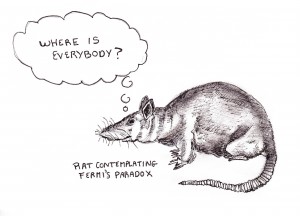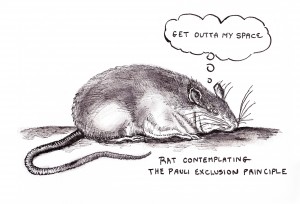Lab rats contemplating alternately Fermi’s Paradox and the Pauli Exclusion Principle (click images to enlarge)
Fermi’s Paradox: Given the vast size and age of the universe (the sheer number of stars, amount of matter, and how long it’s all been swooshing around), probabilistically you’d expect life to be cropping up all over the place. You’d also expect, unless the earth is very atypical, that some life would be much less advanced than us, and some much more. It follows that the more advanced life forms should really be out there, travelling around and colonising the galaxy. But — we haven’t seen anyone much. Hence the paradox.
The Pauli Exclusion Principle: This states that no two electrons can share the same space (or more precisely, the same quantum numbers). As a result of the exclusion principle, electrons are prevented from all bunching up in the lowest energy tier next to the nucleus, and as a result — the need for different energy tiers, the structure of the atom, the shape of the periodic table, all of chemistry, and the reasons for how almost everything in the universe looks, sounds, feels and behaves.
Rats drawings by Hannah Marcus
Concepts for the possible volume The Secret Life of the Lab Rat: C is for Cheese


